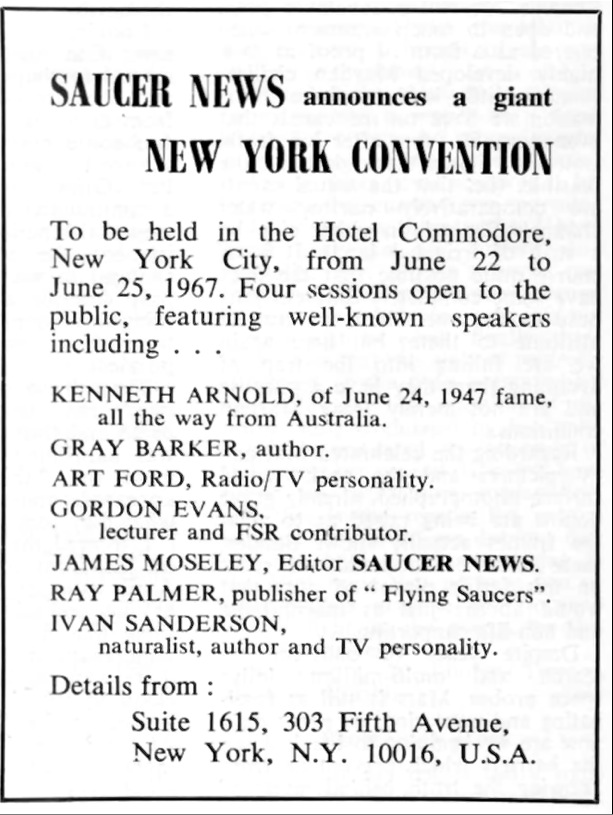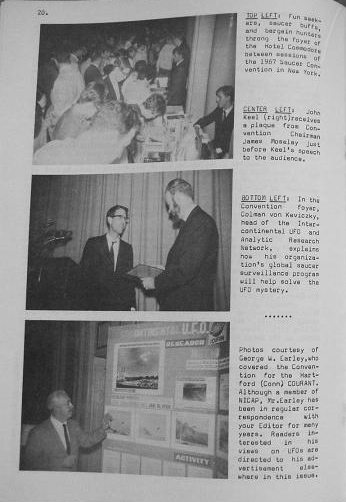The Post-Standard from Syracuse, New York Nov. 21, 1966, featured news of an upcoming UFO lecture by Edward J. Patrick, "Flying Saucers - Fact or Fancy?" A special thanks to Robert Barrow for sending us his clippings on this event he attended in Syracuse so long ago.
After the event, an article in the same newspaper summarized Patrick's lecture.
Syracuse Post-Standard, Dec. 1, 1966
Engineer Says Self-Styled Experts Cause UFO Mystery
 |
| Syracuse Post-Standard, Dec. 1, 1966 |
The fact that a GE engineer was speaking about UFOs added some respectability to things, and while he was skeptical, he did consider the topic worthy of discussion. One of Patrick's lectures was mentioned in NICAP's The UFO Investigator from Jan-Feb 1966, in the article, "Millions Learn of NICAP UFO Evidence." It was cited among their discussion of positive attention towards the UFO topic.
Missiles, Space and Flying Saucers
General Electric was a big contractor for the US government, and their Missile and Space Division was working on military and aerospace projects such as guided missile technology, NASA's space re-entry vehicles and classified strategic programs. It's puzzling why they were involved in lectures on flying saucers. While researching the background on the original clippings, we found that Patrick's UFO lectures continued into 1968, but curiously, there were
other lectures by the same name.
 |
IEEE Almanack, April 1967,
Institute of Electrical and Electronics Engineers, Philadelphia Section |
Who was that unnamed GE scientist? This clip from
Standard-Speaker, April 28, 1966 gives us a clue:
UFO Speaker's Name Listed Incorrectly
The speaker at Tuesday's Kiwanis Club... was Roland Swank, not Richard Socky, as previously published. Both men are employees of the General Electric Missile and Space Division, Mr. Socky was announced as the speaker and was unable to attend. Mr. Swank substituted for him and the Standard-Speaker reporter was not informed of the change. Mr. Swank's topic was "Unidentified Flying Objects."
GE's Missile and Space Division in Philadelphia had at least five people giving the "Fact or Fancy" lecture. Besides Edward J. Patrick and Roland Swank, the same talk was being given by Robert Hersch, Paul Usavage, and Eugene Rygwalski. Some of those guys formed their own UFO organization.
Swank's Systems Management Associates, Inc.
The Philadelphia Inquirer, Nov. 20, 1966, had an article, "Flying Saucer Evidence Compiled by Engineers" by Stephen J. Sansweet that told how GE engineers Roland P. Swank, Gene E. Rygwalski and Robert L. Ewing got started. “They work for a large firm they prefer not to identified – because it has government contracts – and they fear of being pressured to stop their investigation."
Three engineers and about 30 other men, mostly scientist or engineers, have incorporated a group – Systems Management Associates, to gather data on what they call “Unidentified Observations."
Swank, the SMA spokesman, said his interest in UFOs was aroused in November 1961, when he and some co-workers or asked to speak on the subject. “If we were going to talk about UFOs, we felt we owed it to the public to find out what we were talking about," Swank said. Over the years the interest grew. Last February, 30 men formed the Organization for Scientific Analysis and Research. This was incorporated into the SMA two weeks ago.
 |
| The Philadelphia Inquirer, Nov. 20, 1966 |
Unfortunately the article does not name any participants beyond the three principals, so we can't know just who else from GE was involved in the SMA. We found that the group had been corresponding with Richard Hall, who wrote in NICAP’s Affiliate/Subcommittee Newsletter, March 9, 1966, “A Subcommittee consisting of General Electric scientists, engineers and technicians in Philadelphia is about to be approved. Co-chairman will be Eugene Rygwalski, (mathematician)..." However, we found nothing to show the group ever was formally connected to NICAP. An article in
The Philadelphia Inquirer, Nov. 12, 1966, shows that SMA was not always backing winners:
Systems Management Associates co-sponsored in Philadelphia on Friday night the appearance of one of the world’s foremost trackers of flying saucers and assorted other UFOs, Dr. Daniel Fry.
Roland P. Swank and other engineers from General Electric continued to lecture on UFOs all under the same title, "Fact or Fancy," at clubs, schools, churches - anywhere- through 1968.
 |
| Standard-Speaker, Hazleton, Pennsylvania April 23, 1966 |
 |
| The Pittsburgh Press, December 8, 1966 |
 |
| Delaware County Daily Times, November 11, 1967 |
Flying Saucer Company Policy
An article in
Delaware County Daily Times, October 8, 1968 stated, "A series of lectures will be given by personnel of the General Electric Company's Missile and Space Division at the Rose Tree Media Adult School." The topics generally looked to what the future of technology would bring: space exploration, computer use in industry, geology, weather satellite technology, and once again, Edwin J. Patrick lectured on "Flying Saucers - Fact or Fancy?," and it was noted that, "He has given more than 200 talks to technical and civic groups and is the author of an article on UFO's."
How far back did these GE flying saucer lectures go? A calendar of events in the Nov. 11, 1957
Aviation Week magazine showed a listing for one in Feb. 1958.
Feb. 19— "Are Flying Saucers Fact or Fancy?", Dr. Hugh Winn, Missile and Ordnance Systems Department, GE, Engineers Club, 1317 Spruce St„ Philadelphia, Pa.
The Pennsylvania Villanova University newspaper documents a slightly earlier one, Dec. 3, 1957:
 |
| The Villanovan, Dec. 11, 1957 |
The American Engineer from Nov. 1956 is the earliest version of the lecture we found.
“Flying Saucers—Fact or Fancy?” Asks GE Speaker
At a recent meeting of the Valley Forge Chapter of the Pennsylvania SPE, Dr. Hugh Winn, General Electric Company, Philadelphia, Pa., gave an interesting talk to about seventy members and guests on the subject— “Flying Saucers—Fact or Fancy?” Dr. Winn, who works in the Special Defense Projects Department, opened his talk with a reminder that we have five normal senses, illustrating each with an example. From this he brought out the fact that some times our senses lead us to illusions— or thinking that something is—that isn't. He gave examples of instances where a person had reported seeing objects flying through space, but which could not be authenticated by other individuals. Dr. Winn told of flying objects that have been seen with the aid of scientific instruments, such as radar and the camera. The saucer-type objects which were seen for about five hours over Washington, D.C., in 1952 were judged by radar to be flying from 250 to 7,500 miles per hour, he said. On other occasions cigar-shaped objects with estimated speeds up to 21,000 miles per hour were reported. The saucer objects appeared to give off a bluish glow, Dr. Winn stated. There have been numerous written accounts of objects seen in the sky during the past 2,000 years, he said, and maybe flying objects are not new.
It's clear that GE's UFO lecture program inspired Swank's independent SMA group, but there was some significant overlap between them, at least up until 1968. After that, it seems the SMA was on their own and eventually fell on hard times.
Delaware County Daily Times, May 14, 1976, reported on the end of Swank's UFO group:
The Unidentified Observation Reporting Center in Berwyn, after nine years of reporting sightings and the frustration of where to go and what to do next with them as forced it to close active operations. According to a spokesman at the Center, the work was begun in 1967 by a group of 45 scientists and engineers who found who soon found themselves faced with the riddle of how to prove the existence of something with no evidence. “We could determine the 'are nots,'" said the spokesman. "They are not helicopters, they are not spotlights, they are not planes, etc. But how can you say what they actually were. Where do you go from there?"
Despite the end of the Centers operations, Swank lectured on:
The Daily Intelligencer from Doylestown, Pennsylvania on October 27, 1976, contained the last talk we located.
The program will be "Unidentified Observations--Fact or Fantasy" presented by Roland Swank. The subject of the UFO phenomena is one of increasing interest. Swank is a member of Systems Management Associates, Inc., whose prime function is the performance of scientific UFO investigations. Swank has been a systems evaluation engineer with the General Electric Company since 1950.
Beyond that, Roland Swank also continued to
correspond with UFO colleagues at least as late as 1979, but his SMA group left few tracks and is now mostly forgotten.
GE: "Progress is our most important product."
We were unable to find much more about the origins of the General Electric lecture program, but have to wonder why it was promoted by GE's Missile and Space Division for fourteen years or so. The most curious thing is that the program seems to have thrown both some water and gasoline on the fiery UFO topic.
If any of our readers have more information on the GE UFO lectures or Swank's, Systems Management Associates, Inc., please send an update to us here at
The Saucers That Time Forgot.

















































